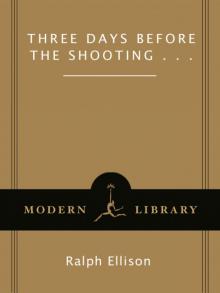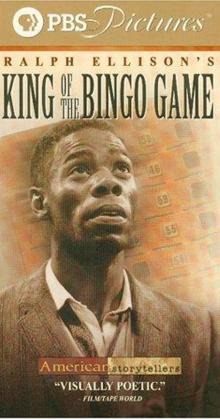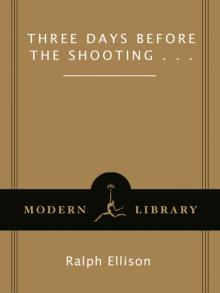- Home
- Ralph Ellison
Flying Home Page 2
Flying Home Read online
Page 2
Learning to write, Ellison amends Hemingway’s creed. He does not seize upon Hemingway’s difficulty of “knowing truly what you really felt”; rather, conscious of the dangers implicit (and explicit) in being a member of the Negro minority in the United States, he stresses not the question of knowing what he felt—he knew that—but the rhetorical problem of how to express it. (This will be Ellison’s genius in Invisible Man: From the opening assertion—“I am an invisible man”—to his closing question—“Who knows but that, on the lower frequencies, I speak for you?”—the eponymous protagonist narrates how he feels in a progression of jazz breaks taking off from and returning to the bass line of invisibility.) Was Ellison thinking of the breaks, the syncopations, the swing of jazz when he wrote in that same reflection on becoming a writer that Hemingway’s prose “did not move straightforwardly as did the familiar prose I knew, and its rhythms were shorter and circular”?
Ellison notes that Hemingway “could distill the great emotion from the most deadpan, casual-appearing, understated effects.” Hemingway’s courage in taking on the “difficulties of convention” and the rhythms and “understated effects of his prose” appealed to Ellison’s sense of his own artistic situation. So it was, he explains, that “several years later when I started trying to write fiction, I selected Hemingway for a model.” As a college student, he had read Hemingway’s stories in barbershop copies of Esquire and his books in the Tuskegee library. Later, in the winter of 1937-38, when he began to feel the writer’s fever, Ellison recalled in a 1984 letter to John Roche, he “walked a mile or so from the Negro section into downtown Dayton” every day to find a copy of The New York Times and “read Hemingway’s dispatches from the Spanish Civil War which [he] studied for style as well as information.”
For young Ellison style was the donnée of art and personality. As a boy living in a state changing rapidly from a frontier territory to the Oklahoma of both the infamous Tulsa riot of 1921 and the hokum and Jim Crow spawned by perennial candidate and eventual governor “Alfalfa Bill” Murray, Ellison yearned, he wrote later in Shadow and Act, “to make any-and-everything of quality Negro American—to appropriate it, possess it, re-create it in our own group and individual images.” Along with several African-American Oklahoma boyhood friends, he dreamed of becoming a Renaissance man in no small part because of the elegant assertions of style by men most would never have associated with such an exalted idea. “Gamblers and scholars, jazz musicians and scientists, Negro cowboys and soldiers from the Spanish-American and First World wars, movie stars and stunt men, figures from the Italian Renaissance and literature, both classical and popular, were combined with the special virtues of some local bootlegger, the eloquence of some Negro preacher, the strength and grace of some local athlete, the ruthlessness of some businessman-physician, the elegance in dress and manners of some headwaiter or hotel doorman.” From these individuals Ellison and his friends sought to create composite models of self. Although these types do not show up per se in his early fiction, the style and feel of their attempts to subvert the world and make reality over in their image mark Ellison’s prose.
3.
After Invisible Man, Ellison’s fiction was given over almost entirely to his novel in progress. And this project, after the amazing, unanticipated success of his first novel, accentuated his natural penchant to revise, revise, revise, and only slowly come to satisfaction about his work. Nonetheless, more than once during the last year of his life, the short stories came to the forefront of Ellison’s consciousness.
The last time I saw him in his apartment before his final illness—on a cold, bright February afternoon ten days shy of his eightieth birthday, in 1994—Ellison spoke of the novel—“the damn transitions are still giving me fits, but I’m having fun”—and then he told me that he wanted to publish his short stories. (A few months earlier, I had collected the published stories and sent them to him in a loose-leaf binder.) Now he hinted that there might be more, and joked about the files crammed into what Mrs. Ellison called “the little room,” off the long, book-teeming hallway of their apartment. But soon he turned his attention to the window and a lone seagull breasting the whitecaps that blew across the Hudson River below. And I forgot his words about the stories until another windy afternoon two Februaries later when I was hunting for a certain section of the novel.
“John,” Mrs. Ellison said. “There’s a box under the dining room table. Have a look.” I rummaged through it, and at the bottom, beneath old magazines, clippings, and duplicate printouts from the novel, I discovered a brown imitation-leather folder with RALPH W. ELLISON embossed in gold letters on the front. Inside, bulging with manuscripts, was a manila folder labeled “Early Stories.” The stories were typed on paper brown with age and beginning to crumble; here and there passages were crossed out, and revisions inserted in Ralph’s hand.
I realized these were stories that had never been published, never been mentioned—stories no one knew about. To my surprise I found that even Mrs. Ellison didn’t know about them, and subsequently, with one or two exceptions, I have not come across mention of the stories in Ellison’s papers. In any case this cache of stories gave impetus and shape to the present collection. Initially, I had put off collecting Ellison’s previously published stories because eight of the pieces—“And Hickman Arrives” (1960); “The Roof, the Steeple and the People” (1960); “It Always Breaks Out” (1963); “Juneteenth” (1965); “Night-Talk” (1969); “A Song of Innocence” (1970); “Cadillac Flambé” (1973), and “Backwacking: A Plea to the Senator” (1977)—were selections from the novel in progress, stories whose fate should await publication of the novel. “Did You Ever Dream Lucky?” (1954) and “Out of the Hospital and Under the Bar” (1963), told by or about Ellison’s indispensable folk character Mary Rambo, were offshoots or originally part of Invisible Man. “Slick Gonna Learn” (1939) and, perhaps indirectly, “The Birthmark” (1940) were related to the Slick novel begun in Dayton and then abandoned for good not long afterward.
Discovery of the more than half-dozen early stories made it possible to put together a volume of Ellison’s best published and unpublished freestanding fiction. From the former I have included the three early Buster-and-Riley stories “Mister Toussan” (1941), “Afternoon” (1940), and “That I Had the Wings” (1943), and latter-day brother to these, “A Coupla Scalped Indians” (1956). (In a batch of notes from 1954 or 1955, Ellison referred to “A Coupla Scalped Indians” as a Buster-and-Riley story, but before publication in 1956, he dropped Riley in favor of an unnamed narrator, perhaps because he thought he might blend the story into the Oklahoma chapters projected for his recently begun second novel. But in the end he did not, and so the story stands as a coda to the earlier Buster-and-Riley fictions.) Three other stories, “In a Strange Country,” “King of the Bingo Game,” and “Flying Home,” were written and published in 1944 while Ellison was serving in the merchant marine—only a year before he wrote the magical first sentence of Invisible Man.
The six stories unpublished in his lifetime—“A Party Down at the Square” (untitled by Ellison), “Boy on a Train,” “Hymie’s Bull,” “I Did Not Learn Their Names,” “A Hard Time Keeping Up” (also untitled), and “The Black Ball”—have more elusive chronologies. Except for “Hymie’s Bull,” Ellison failed to date these stories. Four of them—“A Party Down at the Square,” “Boy on a Train,” “I Did Not Learn Their Names,” and “Hymie’s Bull”—were in the folder with the frayed “Early Stories” label. (Of these, the final draft of “I Did Not Learn Their Names” has Ellison’s 1940 address—25 Hamilton Terrace, New York City—written in black ink at the top of the first page. The impressions made by the typewriter keys are similar enough to suggest that the final versions of these stories, except for “Hymie’s Bull,” were typed in New York.) Two fragmentary sketches, called “Bartender” and “One Man’s Woman,” and a much-worked-over story, by turns melodramatic or flat, variously titled “One Who Was Waiting,” “Goodnight Ir
ene,” and “Irene, Goodnight,” were also in the “Early Stories” folder. Elsewhere in the papers I came across manuscripts of “A Hard Time Keeping Up” and “The Black Ball.” Judging from the letter-heads of the typescripts, these two stories were drafted, if not completely finished or revised, during Ellison’s feverish months of writing in Dayton from late 1937 to April 1938, when he returned to support himself while writing by working on the New York Writers Project of the WPA, a job he stayed with until Angelo Herndon persuaded him to become managing editor of the Negro Quarterly in 1942.
I have not included “A Storm of Blizzard Proportions,” a story that, like “In a Strange Country,” Ellison wrote in 1944 and set in Wales while he was steaming across the North Atlantic on merchant-marine missions to the port of Swansea and other destinations. He wrote two drafts of the story in 1944, then apparently put it aside clipped to a long letter of praise and criticism from a friend, also dated 1944. “A Storm of Blizzard Proportions” has several reveries, influenced by Joyce and Hemingway, focused on Jack Johnson and, later, on the protagonist’s (and Ellison’s) autobiographical association of Wales with the Ohio landscape he came to love after his mother’s death. Excluding the story was all the more painful because Ellison felt attached enough to list it among those he had toyed with collecting more than a decade before his death. I have left it out because, although compelling and suggestive of literary influences on Ellison, the parts of the story do not come together as a convincing whole.
Editing Ellison’s stories, I found myself rehearsing the argument between Edmund Wilson and the Modern Language Association about the nature of posthumous editions. It should be clear that the current volume is emphatically a reader’s edition, not intended to be a variorum or scholarly edition. In most cases the changes I have made to published and unpublished stories alike are silent, minor copyediting corrections. Exceptions are indicated by brackets in the text. For example, in “The Black Ball” I have inserted into the text of the story Ellison’s note describing the little boy, and in the opening paragraph of “Hymie’s Bull” I have restored from an earlier draft a sentence apparently unintentionally left out of what appears to be the story’s final version. Finally, I have given two stories untitled by Ellison titles consisting of a phrase from each story’s respective manuscript.
The present collection chronicles Ellison’s discovery of his American theme. In technique and style, subject matter and milieu, the thirteen stories show the young writer’s promise and possibility in the late thirties and his gradual ascent to maturity in the mid-forties when, unbeknownst to him, he was about to conceive Invisible Man. The sequence I have chosen follows the life Ellison knew and imagined from boyhood and youth in the twenties and early thirties to manhood in the late thirties and early forties. Different faces look out from the stories. Sometimes tolerance and a wary solidarity break through the color line, while on other occasions unspeakable acts of cruelty and violence disfigure the countenance of Ellison’s America. The deceptive Jim Crow “normalcy” of the twenties is here; so are the jolt of the Depression and the opportunity and antagonism of black experience during the Second World War. Throughout the stories, Ellison experiments with narrative technique, point of view, and the impact of geography on personality. Reading them, one is initiated into the protean shapes and guises of black experience from about 1920 to about 1945. Ellison’s fidelity to contemporary reality also enables him to etch timeless patterns on his work, often, as in “Flying Home,” the archetype of a young man passing through loss and desolation “back in[to] the world of men again.”
4.
In an undated, handwritten note at the bottom of a page from his novel in progress Ellison wrote “book of stories,” then the words “story of lynching and airplane. Have Fanny look up.” But I found no further mention of the untitled story I have called “A Party Down at the Square.” Nevertheless, the story is a tour de force, not least, as Ellison remarked of Hemingway’s techniques and effects, because telling it “presented its own difficulties of convention.” By narrating a brutal lynching in the voice of a Cincinnati white boy visiting his uncle in Alabama, Ellison defies what he called in “Twentieth-Century Fiction and the Black Mask of Humanity” (1946) the “segregation of the word,” and crosses the narrative color line then lingering in American literature. Like the black lynching victim, Ellison’s white narrator is unnamed—doubtless, he covets anonymity. Yet everything seen, heard, smelled, touched, and felt while the black man is burning is expressed only in the feelings, words, and point of view of the boy watching.
As the writer, Ellison slips into the breaks and looks around under the skin of his young white narrator. The story is taut with the writer’s restraint and the narrator’s matter-of-fact, frightening, shameless account of the night. The boy speaks an idiom so unself-consciously reportorial that it becomes self-conscious. In his last words the boy tries to both declare and disguise his respect for the murdered man. “It was my first party and my last. God, but that nigger was tough. That Bacote nigger was some nigger!” The repetition of nigger denies, affirms, and again denies the mystery and equality of the human condition.
Ellison subtly plays off what he termed in “Brave Words for a Startling Occasion” that “mood of personal moral responsibility for democracy” he felt had all but disappeared from American literature after classic nineteenth-century fiction yielded to the moderns in the 1920s. In “A Party Down at the Square” he imagines a lynching from the perspective of someone without a moral point of view. His technique compels readers to experience the human condition in extremis, mediated by a stranger hell-bent only on observation and not the act of witness. Except for the black victim, the participants and spectators are white folks from near and far, titillated by the slow, excruciating torture of the “Bacote nigger”—for what crime or affront the narrator gives not the slightest hint; probably he does not know. Intriguingly, Ellison’s words, almost fifty years later, in “An Extravagance of Laughter,” on the ritual meaning of lynching seem a gloss on his early story: “Hence their deafness to cries of pain, their stoniness before the sight and stench of burning flesh, their exhilarated and grotesque self-righteousness.” And things are exactly so. Presently, the onlookers in the story are horrified by the sizzling flesh of a woman electrocuted by a live wire knocked free by an airplane whose pilot, in the confusion and fury of a cyclone, mistakes the lynching’s ring of fire for airport signal flares. But the lynchers’ revulsion is brief; they turn back to the business at hand as if only the veritable end of the world could divert them from burning the black man alive.
The contrast between the human and natural aberrations of lynching and the cyclone is not remarked on by the narrator. His morality is a commitment to be noncommital, as if accuracy depended on neutrality. Ellison’s readers must earn the right to be interpreters. For example, the narrator reveals the sheriff’s presence only when he observes that he and “his men were yelling and driving folks back with guns shining in their hands”—driving them from the deadly live wires back toward the black man still roped to the fiery platform. It need not be said that the sheriff is using his good offices on behalf of the illegal lynching; the effect is conveyed by what Hemingway called “the sequence of motion and fact which made the emotion.” As the action moves inexorably toward accomplishment of the ritual violence, the narrator’s detachment becomes even more chilling, because he has no relation either to the “nigger” or to his own conscience. His sensibility is limited to the mere sensations of conditioned perception, his response so flat and one-dimensional it awakens the reader more keenly to what is taking place. Yet the young white witness testifies in metaphor about the impression left when the black man’s pain is most indelible. “I’ll never forget it. Every time I eat barbeque I’ll remember that nigger. His back was just like a barbecued hog. I could see the prints of his ribs where they start around from his backbone and curve down and around. It was a sight to see, that nigger’s back.” But t
he boy’s most telling response comes from his insides when, to his shame, he throws up. “I was sick, and tired, and weak, and cold.” His sensations are his response, and they signify a resistance to the values he’s been taught not to question. Afterward, the narrator says, “It blew for three days” and, in a reflex verbal action, gives recurring ambivalent testimony to the toughness of the murdered man. Beyond him, Ellison’s sleight of hand leaves readers feeling that what has happened will not blow over in the aftermath of nature’s storm—or man’s.
“A Party Down at the Square” is an anomaly. Told by a white boy, the tale creates a stark background for Ellison’s exploration of African-American life and character in the stories that follow. In between “A Party Down at the Square” and “Flying Home” (“ ‘… they tell me I caused a storm and a coupla lynchings down here in Macon County,’ ” old black Jefferson says in his folktale within “Flying Home”), the stories follow Ellison’s imagined trajectory of black experience from boyhood and youth to manhood. In contrast to “A Party Down at the Square,” where fact and sensation threaten to overwhelm the whole of consciousness, the other stories depend on the characters’ “conscientious consciousness.” The young white narrator in “A Party Down at the Square” survives without probing the meaning of things; in this Alabama town the shallower his responses, the better he’ll do. Not so Ellison’s other narrators and characters. As black Americans, their lives depend on knowing both what it was all about and how to live in it.

 Juneteenth
Juneteenth Invisible Man
Invisible Man Three Days Before the Shooting . . .
Three Days Before the Shooting . . . Flying Home and Other Stories
Flying Home and Other Stories King of the Bingo Game
King of the Bingo Game Flying Home
Flying Home Three Days Before the Shooting ...
Three Days Before the Shooting ...